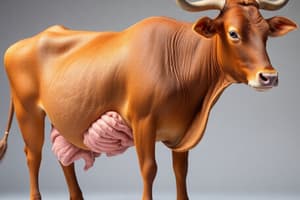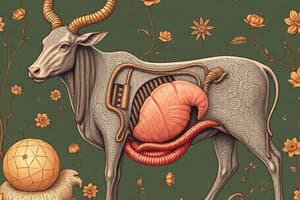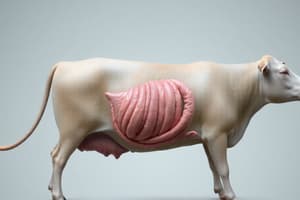Podcast
Questions and Answers
What is the main purpose of conducting a proximate analysis in animal nutrition?
What is the main purpose of conducting a proximate analysis in animal nutrition?
- To determine the palatability of different feeds.
- To evaluate the cost-effectiveness of feed options.
- To establish the proportion of nutrients within a feed. (correct)
- To assess the safety of the feed composition.
During digestion in monogastric animals, which substance begins the chemical breakdown of carbohydrates?
During digestion in monogastric animals, which substance begins the chemical breakdown of carbohydrates?
- Cellulose
- Proteins
- Amylase (correct)
- Saliva
What primarily influences the formulation of animal feeds in terms of cost?
What primarily influences the formulation of animal feeds in terms of cost?
- Nutritional requirements of the animal.
- Variety of feed ingredients available.
- Selection of the cheapest suitable option. (correct)
- Palatability of the feed.
Which nutrient is primarily required for the growth of both lean tissue and fat in animals?
Which nutrient is primarily required for the growth of both lean tissue and fat in animals?
What is the role of chewing in the digestive process of monogastric animals?
What is the role of chewing in the digestive process of monogastric animals?
Flashcards
Nutrient
Nutrient
A substance essential for maintaining life, found in a diet. Feeds contain ash, water, carbohydrates (including nitrogen free extract and cellulose), crude protein, and ether extracts.
Proximate analysis
Proximate analysis
A method used to determine the nutrient content of feed. This helps determine the proportion of each nutrient in the feed.
Growth (in terms of animal nutrition)
Growth (in terms of animal nutrition)
Refers to the accumulation of lean and fat tissue. Lean growth needs energy and amino acids, while fat growth only requires energy.
Feed formulation
Feed formulation
Signup and view all the flashcards
Amylase (in pig digestion)
Amylase (in pig digestion)
Signup and view all the flashcards
Study Notes
Monogastric Digestion
- A nutrient is a substance essential for life, found in feed. Feed components include ash, water, carbohydrates (nitrogen-free extract and cellulose), crude protein, and ether extracts. Nutrient proportion analysis is determined via proximate analysis.
- Growth involves accumulation of lean tissue and fat. Lean growth requires energy and amino acids, while fat growth solely requires energy.
- Feed formulation depends on animal nutritional needs and feed composition, aiming for the cheapest option.
- Digestion begins in the mouth with chewing, increasing surface area for enzymatic breakdown. Saliva initiates carbohydrate digestion in pigs due to amylase.
- The stomach maintains a pH <4, achieved by HCl produced by parietal cells. This acidic environment kills pathogenic bacteria like Escherichia coli. Pepsinogen, produced by chief cells, requires a pH of 1.5-3.5 to be activated into pepsin, thus initiating protein digestion.
- The stomach also performs mechanical digestion through churning. Goblet cells in the stomach lining produce mucus. Regions include the cardiac (mucus production), fundic (HCl, mucus, and pepsinogen secretion), and pyloric (mucus secretion) regions.
- H. pylori colonizes the stomach, converting urea into ammonia and carbon dioxide, neutralizing its immediate environment. Piglets may require added acidity in their diets.
Monogastric Carbohydrate Digestion
- Starch is composed primarily of alpha 1-4 linkages with some alpha 1-6 linkages. Monogastrics have endogenous enzymes (amylase) for starch degradation.
- Cellulose is composed of beta 1-4 linkages. Monogastrics lack the enzyme cellulase, making cellulose degradation problematic.
Monogastric Protein Digestion
- Proteins are broken down into polypeptides by pepsin in the stomach. Peptidases further degrade polypeptides into amino acids, which are then absorbed.
- Proteins that escape digestion in the small intestine enter the large intestine. Microbial deamination in the large intestine leads to the formation of toxic metabolites.
- Ileal amino acid digestibility (apparent digestibility) overestimates protein utilization by not accounting for microbial activity, fermentation, and endogenously produced and fermented proteins. True ileal digestibility considers basal and feed-specific losses.
Monogastric Energy
- Energy is derived from carbohydrates, fats, and proteins. Degradable carbohydrates are converted into glucose and short-chain fatty acids (SCFA/VFA).
- Energy is required for physical and mental tasks and is measured in Joules or calories, with 1 calorie being equivalent to 4.14 Joules.
- Factors affecting feedstuff energy content include age, degree of saturation, free fatty acids, and chain length.
Monogastric Minerals
- Minerals are inorganic elements essential for body functions. Bioavailability of minerals varies, potentially impacted by factors like oxalate or phytate.
- Calcium (Ca++) is the most abundant mineral, primarily found in bones and teeth. Other relevant macro-minerals include potassium, phosphorus, chloride, sodium, sulphur, and magnesium. Micro-minerals such as iron, iodine, and selenium also play crucial roles.
- Adequate Ca++ and P ratios (e.g. 2:1.5 for Mg and P) are essential for optimal absorption and utilization. Deficiency symptoms include problems like osteomalacia.
- Several factors influence mineral absorption, such as the form of the mineral, pH, and the presence of other nutrients.
Monogastric Feed Formulation
- Feed formulation considers energy and nutritional needs of the animal. Knowledge of feed composition is utilized to formulate a balanced diet with lowest possible cost.
- Methods like Near Infrared Spectrophotometry (NIR) analyze feed composition for efficient formulation.
Digestion in other species
- Chick digestion: Food is consumed via the beak and transported to the crop for moistening before undergoing chemical breakdown in the proventriculus (glandular stomach), followed by mechanical breakdown in the gizzard. The cloaca is a common opening for the digestive, reproductive, and urinary tracts.
- Hind-gut fermentors (e.g., the horse) have enlarged large intestines for microbial breakdown of cellulose into volatile fatty acids, which the animal utilizes. Microbial protein is not utilized fully as in ruminant species.
Studying That Suits You
Use AI to generate personalized quizzes and flashcards to suit your learning preferences.




